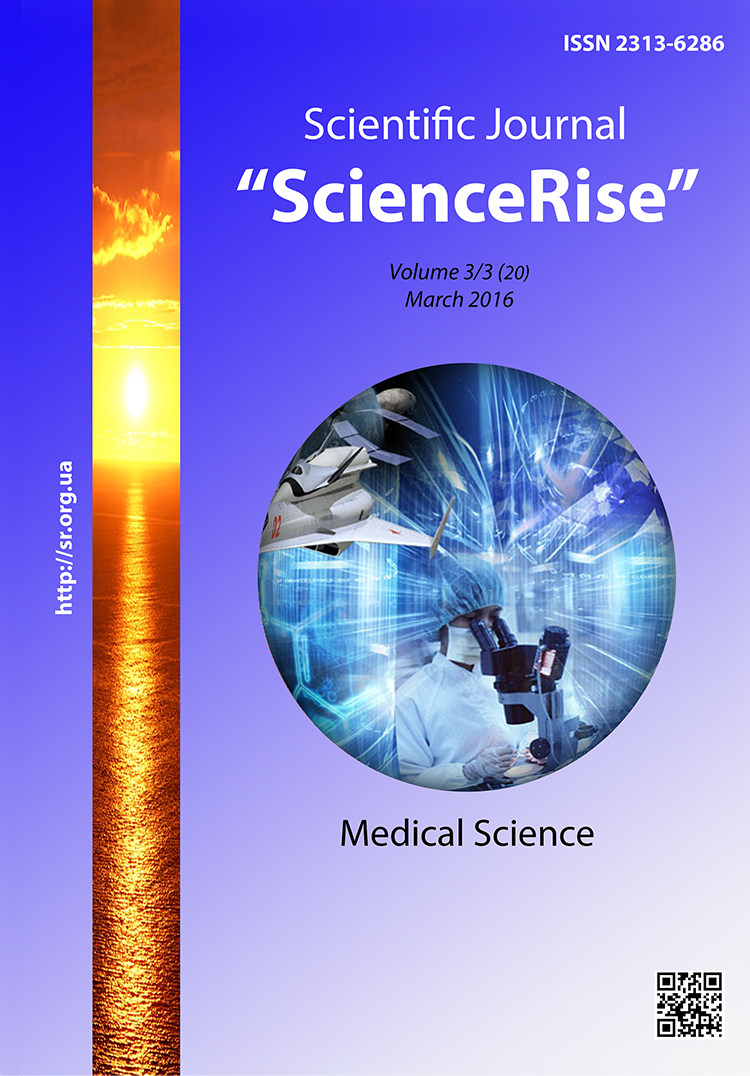Показники функційного стану печінки у хворих на неалкогольну жирову хворобу у поєднанні з кардіоваскулярною патологією печінки в динаміці лікування
DOI:
https://doi.org/10.15587/2313-8416.2016.63016Ключові слова:
неалкогольна жирова хвороба печінки, показники функційного стану печінки, комбінована терапіяАнотація
Досліджено основні показники функційного стану печінки у хворих на неалкогольну жирову хворобу печінки з ізольованим перебігом, у поєднанні гіпертонічною хворобою та у поєднанні з гіпертонічною хворобою та ішемічною хворобою серця у динаміці лікування. На тлі комбінованої терапії відмічалася достовірна тенденція до нормалізації показників функційного стану печінки
Посилання
Bhala, N., Angulo, P., van der Poorten, D., Lee, E., Hui, J. M., Saracco, G. et. al (2011). The natural history of nonalcoholic fatty liver disease with advanced fibrosis or cirrhosis: An international collaborative study. Hepatology, 54 (4), 1208–1216. doi: 10.1002/hep.24491
Ismail, M., Pinzani, M. (2009). Reversal of liver fibrosis. Saudi Journal of Gastroenterology, 15 (1), 72. doi: 10.4103/1319-3767.45072
Farrell, G. C., Rooyen, D. van, Gan, L., Chitturi, S. (2012). NASH is an Infl ammatory Disorder: Pathogenic, Prognostic and Therapeutic Implications. Gut Liver, 6 (2), 149–171. doi: 10.5009/gnl.2012.6.2.149
Takaki, A., Kawai, D., Yamamoto, K. (2013). Multiple Hits, Including Oxidative Stress, as Pathogenesis and Treatment Target in Non-Alcoholic Steatohepatitis (NASH). International Journal of Molecular Sciences, 14 (10), 20704–20728. doi: 10.3390/ijms141020704
Conde, J., Scotece, M., Gómez, R., López, V., Gómez-Reino, J. J., Lago, F., Gualillo, O. (2011). Adipokines: Biofactors from white adipose tissue. A complex hub among inflammation, metabolism, and immunity. BioFactors, 37 (6), 413–420. doi: 10.1002/biof.185
Beaton, M. D. (2012). Current treatment options for non-alcoholic fatty liver disease and non-alcoholic steatohepatitis. Can J Gastroenterol., 26 (6), 353–357.
Teranishi, T., Ohara, T., Maeda, K., Zenibayashi, M., Kouyama, K., Hirota, Y. et. al (2007). Effects of pioglitazone and metformin on intracellular lipid content in liver and skeletal muscle of individuals with type 2 diabetes mellitus. Metabolism, 56 (10), 1418–1424. doi: 10.1016/j.metabol.2007.06.005
Chapman, M. J., Ginsberg, H. N., Amarenco, P., Andreotti, F., Boren, J., Catapano, A. L. et. al (2011). Triglyceride-rich lipoproteins and high-density lipoprotein cholesterol in patients at high risk of cardiovascular disease: evidence and guidance for management. European Heart Journal, 32 (11), 1345–1361. doi: 10.1093/eurheartj/ehr112
Cabezas, G. R. (2004). Effect of ursodeoxycholic acid combined with statins in hypercholesterolemia treatment: a prospective clinical trial. Rev Clin Esp., 204 (12), 632–635.
Mukherjee, S. (2011). Betaine and nonalcoholic steatohepatitis: Back to the future? World Journal of Gastroenterology, 17 (32), 3663. doi: 10.3748/wjg.v17.i32.3663
Paschos, P., Tziomalos, K. (2012). Nonalcoholic fatty liver disease and the renin-angiotensin system: Implications for treatment. World J Hepatol., 4 (12), 327–331. doi: 10.4254/wjh.v4.i12.327
Huang, M., Li, X., Meng, Y., Xiao, B., Ma, Q., Ying, S. et. al (2010). Upregulation of angiotensin-converting enzyme (ACE) 2 in hepatic fibrosis by ACE inhibitors. Clinical and Experimental Pharmacology and Physiology, 37 (1), e1–e6. doi: 10.1111/j.1440-1681.2009.05302.x
Li, L., Luo, Z., Yu, H., Feng, X., Wang, P., Chen, J. et. al (2012). Telmisartan improves insulin resistance of skeletal muscle through peroxisome proliferator-activated receptor-δ activation. Diabetes, 62 (3), 762–774. doi: 10.2337/db12-0570
Bosch, J. (2010). Carvedilol for portal hypertension in patients with cirrhosis. Hepatology, 51 (6), 2214–2218. doi: 10.1002/hep.23689
Hobolth, L., Bendtsen, F., Hansen, E. F., Møller, S. (2014). Effects of carvedilol and propranolol on circulatory regulation and oxygenation in cirrhosis: A randomised study. Digestive and Liver Disease, 46 (3), 251–256. doi: 10.1016/j.dld.2013.10.013
Ko, S. Y., Kim, J. H., Choe, W. H., Kwon, S. Y., Lee, C. H. (2011). Pharmacotherapy alone vs endoscopic variceal ligation combination for secondary prevention of oesophageal variceal bleeding: meta-analysis. Liver International, 32 (5), 867–869. doi: 10.1111/j.1478-3231.2011.02681.x
##submission.downloads##
Опубліковано
Номер
Розділ
Ліцензія
Авторське право (c) 2016 Олександр Петрович Козлов

Ця робота ліцензується відповідно до Creative Commons Attribution 4.0 International License.
Наше видання використовує положення про авторські права Creative Commons CC BY для журналів відкритого доступу.
Автори, які публікуються у цьому журналі, погоджуються з наступними умовами:
1. Автори залишають за собою право на авторство своєї роботи та передають журналу право першої публікації цієї роботи на умовах ліцензії Creative Commons CC BY, котра дозволяє іншим особам вільно розповсюджувати опубліковану роботу з обов'язковим посиланням на авторів оригінальної роботи та першу публікацію роботи у цьому журналі.
2. Автори мають право укладати самостійні додаткові угоди щодо неексклюзивного розповсюдження роботи у тому вигляді, в якому вона була опублікована цим журналом (наприклад, розміщувати роботу в електронному сховищі установи або публікувати у складі монографії), за умови збереження посилання на першу публікацію роботи у цьому журналі.

